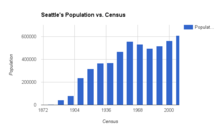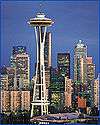Demographics of Seattle
The city of Seattle, in the U.S. state of Washington, was estimated in 2018 by the U.S. Census Bureau to have 744,955 residents.
Population
| Historical population | |||
|---|---|---|---|
| Census | Pop. | %± | |
| 1860 | 188 | — | |
| 1870 | 1,151 | 512.2% | |
| 1880 | 3,533 | 207.0% | |
| 1890 | 42,837 | 1,112.5% | |
| 1900 | 80,671 | 88.3% | |
| 1910 | 237,194 | 194.0% | |
| 1920 | 315,312 | 32.9% | |
| 1930 | 365,583 | 15.9% | |
| 1940 | 368,302 | 0.7% | |
| 1950 | 467,591 | 27.0% | |
| 1960 | 557,087 | 19.1% | |
| 1970 | 530,831 | −4.7% | |
| 1980 | 493,846 | −7.0% | |
| 1990 | 516,259 | 4.5% | |
| 2000 | 563,374 | 9.1% | |
| 2010 | 608,660 | 8.0% | |
| Est. 2018 | 744,955 | [1] | 22.4% |
| source:[2][3] | |||
As of the U.S. Census of 2000, there were 563,374 people, 258,499 households, and 113,481 families residing in the city of Seattle. The population density was 2,593.5/km² (6,717.0/mi²). There were 270,524 housing units at an average density of 1,245.4/km² (3,225.4/mi²).
During the day, incoming commuters increase Seattle's population by over 160,000 people. This makes the city's daytime population rise from about 560,000 to over 720,000 according to estimates based on the 2000 Census.[7]
The racial composition of the city in 2016 was 65.7% white, 14.1% Asian, 7.0% Black, 0.4% Native American, 0.9% Pacific Islander, 2.3% from other races, and 5.6% from two or more races. 6.6% of the population is Hispanic or Latino of any race.[8] Amongst the city's European origin population, 11.3% were of German, 9.1% Irish, 8.1% English and 5.0% Norwegian ancestry according to Census 2000.
According to Census 2010, there were a total of 283,510 households in Seattle. Of these, 42.9% were family households and 57.1% were non-family households. A total of 19.5% of households had children under 18 years, and 17.6% had someone over the age of 65. The average household size was 2.06, while the average family size was 2.87.[9] The city is second-last in terms of households with children, with only 19.1% of households reporting children under 18 living with them. Only San Francisco has a lower percentage of families with children.[10] Seattle also sports the fifth-highest percentage of adults living alone in the country.[11][12]
In the city the population was spread out with 15.6% under the age of 18, 11.9% from 18 to 24, 38.6% from 25 to 44, 21.9% from 45 to 64, and 12.0% who were 65 years of age or older. The median age was 35 years. For every 100 females, there were 99.5 males. For every 100 females age 18 and over, there were 98.8 males.
The median income for a household in the city was $45,736, and the median income for a family was $62,195. Males had a median income of $40,929 versus $35,134 for females. The per capita income for the city was $30,306. 11.8% of the population and 6.9% of families were below the poverty line as were 13.8% were under the age of 18 and 10.2% are 65 or older.
Seattle has the largest African American population of any city in the Pacific Northwest, it is largely concentrated in the Central District, High Point and Rainier Beach neighborhoods. While Seattle's Hispanic population is only 6.6%, it is largely concentrated on the city's South Park neighborhood.
In addition, the city has seen a major uptick in immigration in recent decades. The foreign-born population increased 40 percent between the 1990 and 2000 census.[13] Although the 2000 census shows only 5.28% of the population as Hispanic or Latino of any race, Hispanics are believed to be the most rapidly growing population group in Washington State, with an estimated increase of 10% just in the years 2000–2002.[14]
Housing and homeless issues
Estimates of Seattle's homeless population put the number somewhere around 6,000 to 8,000 people; up to 1,000 are children and young adults. As of January 27, 2017, according to the Point-In-Time Count in Seattle/King County, an annual count of individuals, youth, and families experiencing homelessness in Seattle and King County, there were a total of 11,643 individuals experiencing homelessness, of which 47% were unsheltered, which included 13% on the street, 20% in vans or RVs, 13% in tents and 1% in abandoned buildings.[15]
In March 2004, Seattle was recognized in a report released by the United States Department of Housing and Urban Development as one of the seven cities in the United States that are leading the way toward reducing chronic homelessness. (The other cities are Birmingham, Alabama; Boston; Columbus, Ohio; Los Angeles; Philadelphia; and San Diego.) Many of the services cited are funding fairly traditional programs, such as homeless shelters, emergency shelters, low-income housing, and hygiene programs. Also, the Community Psychiatric Clinic in Seattle provides housing for about 5,000 homeless mentally ill clients per year. There are also private shelters, soup kitchens, and food banks. The Seattle Housing Authority also provides 5,300 low-income public housing units for over 24,000 residents. Its first development, Yesler Terrace (1942), was the first public housing development in Washington and the first integrated such development in the country.
Seattle also has some more innovative programs run by nonprofit groups. Real Change is a street newspaper sold by homeless individuals to provide them an income without panhandling. FareStart provides job training and placement in the food preparation industry and provides food service in the Seattle Central Library. The Homelessness Project, Seattle Youth Garden Works and YMCA's Working Zone help the homeless get training, jobs and housing.
Seattle has also provided some of the locations for the series of homeless encampments known as Tent City. Tent Cities are largely self-policing, with strict regulations, such as no alcohol, no drugs, and segregated areas for families, men, and women.
Ethnic groups
Ethnic groups in Seattle, according to the 2010 United States Census.
According to the 2010 United States Census, Seattle had a population of 608,660 with a racial and ethnic composition as follows:[16]
- White: 69.5% (Non-Hispanic Whites: 66.3%)
- Asian: 13.8% (4.1% Chinese, 2.6% Filipino, 2.2% Vietnamese, 1.3% Japanese, 1.1% Korean, 0.8% Indian, 0.3% Cambodian, 0.3% Laotian, 0.2% Pakistanis, 0.2% Indonesian, 0.2% Thai)
- Black or African American: 7.9%
- Hispanic or Latino (of any race): 9.0% (4.0% Mexican, 2.3% Puerto Rican, 1.3% Colombian, 0.2% Guatemalan, 0.2% Salvadoran, 0.2% Cuban)
- American Indian and Alaska Native: 0.8%
- Native Hawaiian and Other Pacific Islander: 0.4%
- Other race: 2.4%
- Two or more races: 5.1%
Religion
Seattle residents identify as mostly of various Christian (52%), but with a large portion of irreligious. Seattle residents' current religious affiliations are shown in the table below:[17][18]
- Christianity 52%
- Protestantism 34%
- Evangelical Protestant 23%
- Mainline Protestant 10%
- Historically Black Protestant 1%
- Catholicism 15%
- Mormonism 1%
- Jehovah's Witness 1%
- Other Christian 1%
- Protestantism 34%
- Non-Christian Faiths 10%
- Unaffiliated 37%
See also
- Homelessness in Seattle
- History of the Chinese Americans in Seattle
- History of the Japanese in Seattle (Japanese Americans and temporary expatriates)
References
- "Annual Estimates of the Resident Population for Incorporated Places over 50,000, Ranked by July 1, 2011 Population: April 1, 2010 to July 1, 2011 (SUB-EST2011-01)". United States Census Bureau. Archived from the original (CSV) on August 21, 2012.
- Moffatt, Riley. Population History of Western U.S. Cities & Towns, 1850–1990. Lanham: Scarecrow, 1996, 332.
- "Subcounty population estimates: Washington 2000–2007". United States Census Bureau, Population Division. March 18, 2009. Archived from the original (CSV) on March 31, 2009. Retrieved April 27, 2009.
- "Archived copy". Archived from the original on 2012-08-21. Retrieved 2012-08-01.CS1 maint: archived copy as title (link)
- Moffatt, Riley. Population History of Western U.S. Cities & Towns, 1850–1990. Lanham: Scarecrow, 1996, 332.
- "Subcounty population estimates: Washington 2000–2007". United States Census Bureau, Population Division. March 18, 2009. Archived from the original (CSV) on March 31, 2009. Retrieved April 27, 2009.
- https://www.seattle.gov/opcd/population-and-demographics/about-seattle#raceethnicity
- "Archived copy". Archived from the original on 2014-03-05. Retrieved 2012-02-25.CS1 maint: archived copy as title (link)
- "Archived copy". Archived from the original on 2014-03-22. Retrieved 2012-06-08.CS1 maint: archived copy as title (link)
- "Archived copy". Archived from the original on 2005-01-07. Retrieved 2004-12-22.CS1 maint: archived copy as title (link)
- Applied Survey Research. "Seattle/King County Point-In-Time Count of Persons Experiencing Homelessness 2017" (PDF). All Home King County. Retrieved 18 December 2017.
- Bureau, U.S. Census. "American FactFinder - Results". factfinder.census.gov. Archived from the original on 2020-02-12. Retrieved 2015-11-10.
- "Adults in the Seattle metro area". Pew Research Center.
- Major U.S. metropolitan areas differ in their religious profiles, Pew Research Center

